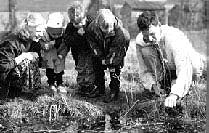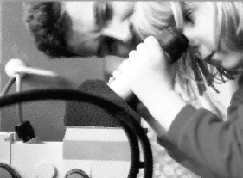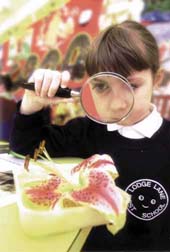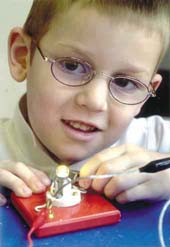

What was it going to be like having a partner? It seemed a bit like blind date except that someone else made the choice for you. Would it work? Would we end up commenting on each other’s faults? Would it be a happy time with promises to meet again or a dismal encounter with a vow never to see each other again?
I had first heard about the TSN in February 1994 and was immediately taken with the idea.
We can all learn from each other, teachers need to continue to
add to their own knowledge by encouragement rather than the threatening
climate we have sometimes experienced. Children, too, benefit
from contacts outside the rather sheltered world of school. It
all sounded like a very good idea, and I’m all for being part
of good ideas.
The induction meeting made clear that these were to be partnerships of equals but were to be teacher-led rather than dominated by the world of science. Even better, except that having the responsibility for leading seemed a bit daunting. What was this going to mean for me?
Dr. Mark Leech turned out to be approaching seven feet tall, does amazing things with DNA at the John Innes centre and would be able to bring plants and a microscope into school.
I had specifically requested a partner who was a botanical scientist as the school felt we needed to be making more of our wild-life area. It therefore seemed to make most sense to make this clear at the outset so that our needs were made known.
The initial stages of any relationship are full of worries and
misunderstandings, about who should be phoning whom; ‘is he coming
this Thursday or next, whatever will he think about the mess in
my classroom, what am I expected to do?’ 
We have both been on a learning curve, but it has been learning rather than failing. It has been a pleasure to have someone from the outside world into the classroom. It has helped me to feel that I am part of the outside world. It has also been quite humbling to watch someone of such experience and expertise get down on his hands and knees to talk to four and _ve year olds about the wonders of nature. He has opened up the world to them in ways that I am just not able to do.
It has also been amusing to watch his nonplussed expression when the children ask him quite unexpected questions such as ‘How do dragons fly?’ and ‘Why are scientists so tall?’
I have also been to the John Innes Centre so that I could see what Mark was doing. I did my best to understand… it gave me an insight into how children sometimes feel. What was most fascinating was Mark’s enthusiasm for his job, his belief in what he is doing and the quiet confidence that it gives him.
I am more convinced than ever that we can all learn from each other, that we teachers need encouragement and that children benefit from contacts with the world outside the school.
For Science Week this year we decided to throw open our classrooms so that our children’s families could join in the activities. Our Science Open Day reflected the many aspects of science that are usually going on in our classrooms. It included experiments with magnets, comparing materials, floating, sinking, completing electrical circuits and investigating how far vehicles travel when sent down slopes. But the highlight of the day was a visit by our TSN science partner, Dr. Mark Leech, a cell biologist from the John Innes  Centre.
Centre.
Mark brought along pots of wheat, rice and pea plants as well as a high-powered microscope. The children and their families were fascinated by what they could see under such high magnification and Mark was on hand to show how to prepare plant material for viewing under the microscope.
 Taking part in a national event like this raises the profile of science generally and within school. It also gives the children a chance to share what they have been learning with their parents and siblings. And just as importantly, it encourages and supports us, the teachers, making the work involved appreciated and well worth while.
Taking part in a national event like this raises the profile of science generally and within school. It also gives the children a chance to share what they have been learning with their parents and siblings. And just as importantly, it encourages and supports us, the teachers, making the work involved appreciated and well worth while.
Colour pictures in this article courtesay of the Norwich Evening News.